Toni is a passionate and precise medical cannabis gardener. He knew nothing about cannabis until 2006 when he was diagnosed with fibromyalgia, a painful and debilitating disease. After seeking relief through prescription pills and, later, through cannabis, Toni found that consuming cannabis makes his days less painful. Cannabis also gives him an appetite and energy to enjoy life. Like so many medical cannabis patients, Toni traded a handful of prescription pills for medicinal cannabis.
As a medical patient, Toni has a passion for cannabis cultivation. He is constantly experimenting with new varieties and products, collecting information, and fine-tuning his gardens. This case study follows one of his gardens and interjects a few examples from past gardens.
Toni is an expert photographer. When it came time to write up the research from my garden visits and interviews with Toni, it was difficult to pare down the photos and detailed information about his gardens.
Toni is a stickler for cleanliness and order in the garden. Cleanliness and the prevention of diseases and pests are at the top of his list. He took weekly steps during the vegetative growth stage to prevent fungus, insects and mites, and their eggs.
Cleanliness + Organization = Success!
| Variety Grown | Seed Company | Vegetative Days | Flowering Days |
| ‘Jack 47’ | Sweet Seeds | 37 | 67 |
| ‘Black Jack’ | Sweet Seeds | 37 | 67 |
| ‘Kalashnikova’ | Green House Seed Company | 41 | 57 |
| ‘Lavender’ | Soma Seeds | 33 | 55 |
| ‘Somango’ | Soma Seeds | 36 | 70 |
| ‘Pakistan Chitral Kush’ | CannaBioGen | 40 | 63 |
Seeds and Seedlings
Toni avoids growing autoflowering feminized plants. He finds they require too much light (20 hours daily) and electricity for the amount of production rendered. (But increasing the hours of light increases harvest weight up to 30 percent.)
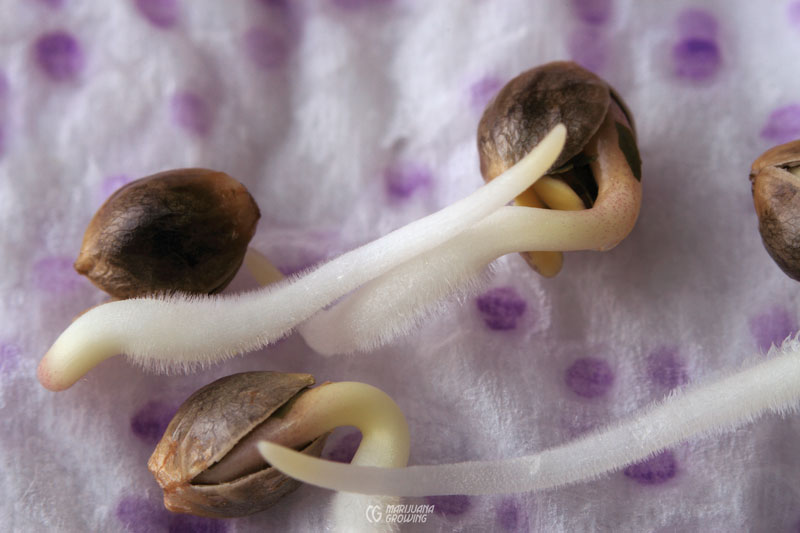
The feminized ‘Black Jack’ (Sweet Seeds) seeds shown here had been germinated in moist paper towels and were ready to plant. Much of this rootlet was covered with delicate feeding roots that quickly spread out into the growing medium.
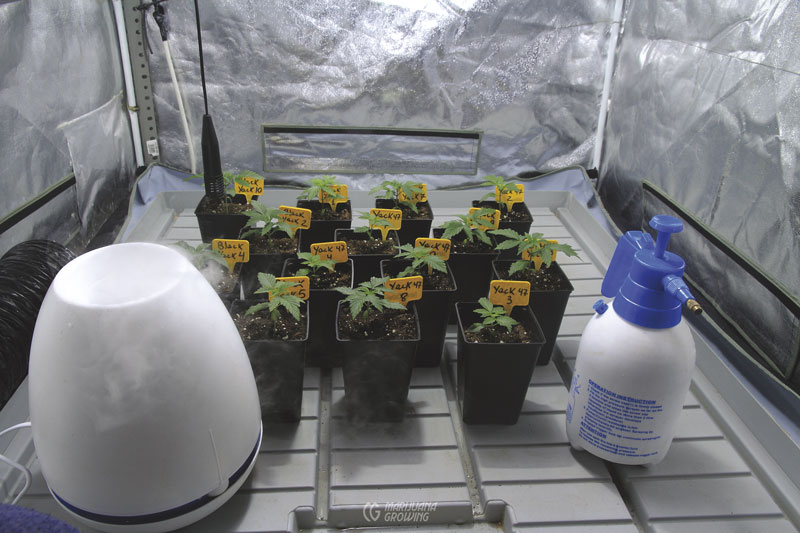
Eight feminized ‘Black Jack’ and 8 feminized ‘Jack 47’ (Sweet Seeds) were germinated in 1.1-quart (1 L) containers growing under a 400-watt metal halide. This photo was taken 20 days after germination. The small plants were watered with dilute Root Juice (EC 720 mS, pH 6.2). A humidifier helped protect clones from moisture stress.
Vegetative Growth
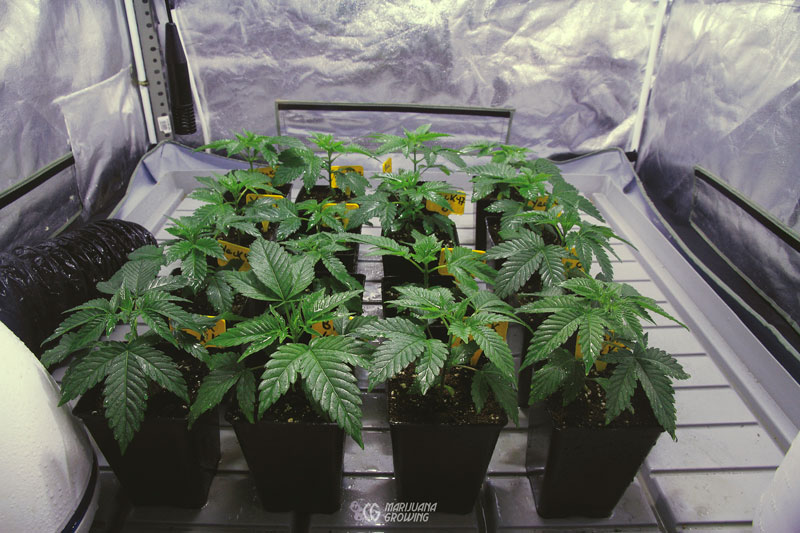
A 400-watt metal halide illuminated 16 feminized ‘Kalashnikova’ seedlings (Green House Seed Company) grown in 1.1-quart (1 L) containers. The plants had recently been sprayed with nutrient solution having an EC of 250 mS at pH 6.0.
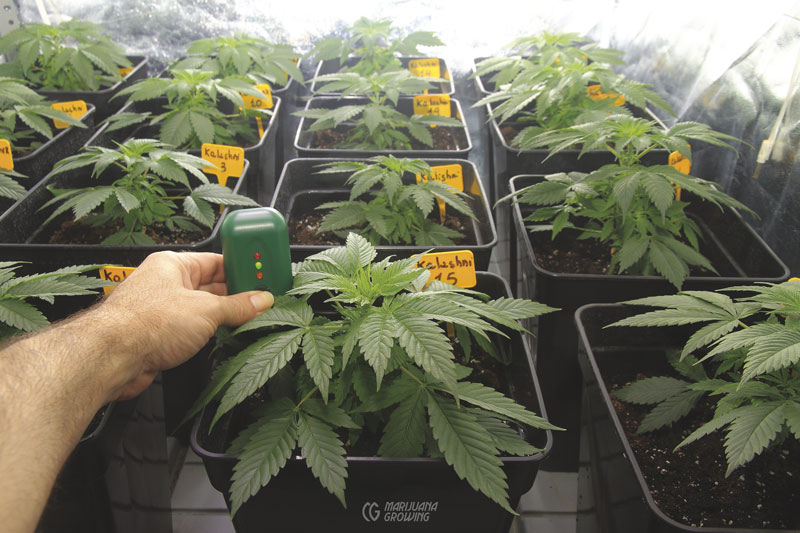
Sixteen feminized ‘Kalashnikova’ seedlings were transplanted into 3-gallon (11.4 L) containers and packed into this grow tent. A fertometer was used to measure electrical conductivity in the substrate to reveal the overall fertilizer strength.
Toni applied the following fungicides in weekly rotation: tetraconazole, penconazole, and myclobutanil. He used a handheld UVC lamp (CleanLight Hobby Unit from HortiTec) to kill fungus and insects, as well as mites and their eggs. He also used a sulfur vaporizer; see “Sulfur Burners”.
HPS and LED Lights
A combination of light-emitting diode (LED) and high-pressure sodium (HPS) light illuminated this garden. Plants needed less light during vegetative growth. Toni used 400 watts for the first 33 to 40 days of growth. At flowering, the ballast was set to full power, and the HPS emitted the maximum amount of light.
The LEDs were of different colors and emitted the perfect spectrum for medical cannabis growth. They were placed around the HPS lamp to augment spectrum. The entire canopy of plants grew evenly because it received the same amount and proper spectrum of light.
As a rule, HIDs were kept at 14 inches (35.6 cm) from the canopy of the garden to provide maximum intensity and even coverage. LEDs were kept about 6 inches (15.2 cm) above the tops of plants. But if the temperature climbed beyond 75ºF (23.9ºC) at the tips of buds, Toni raised the lights so plants would not get too hot.
LEDs must run at the correct temperature to operate properly. Beyond the narrow operating-temperature band of maximum efficiency, LED light output falls drastically and spectrums become unstable. See “Light-Emitting Diode (LED) Lamps” in chapter 17, Light, Lamps & Electricity.
| GROWTH STAGE | ILLUMINATION | WATTS | HOURS |
| seedling | fluorescent | 40 | 18 |
| vegetative | metal halide | 400 | 18 |
| flowering | HPS 600+ LED 420 vatios | 1120 | 12 |
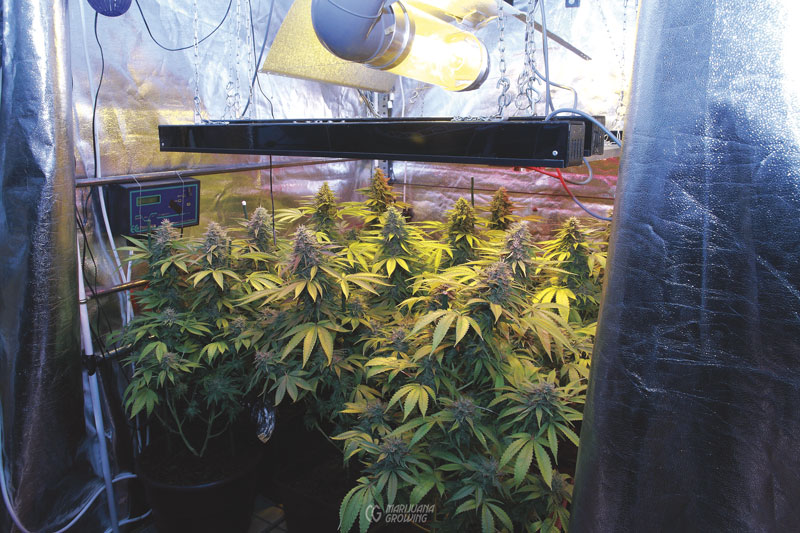
The concentrated HID and LED light penetrated 28 inches (71.1 cm) into the canopy covered in buds.
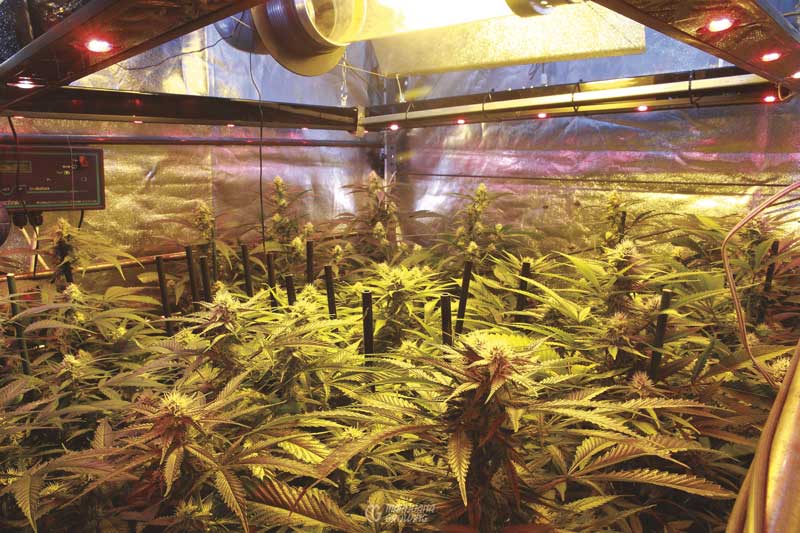
Even with the intense light provided by the 600-watt HPS (Cool Tube) and 300 watts of LEDs, all the light was used by plants. No light shined on the floor.
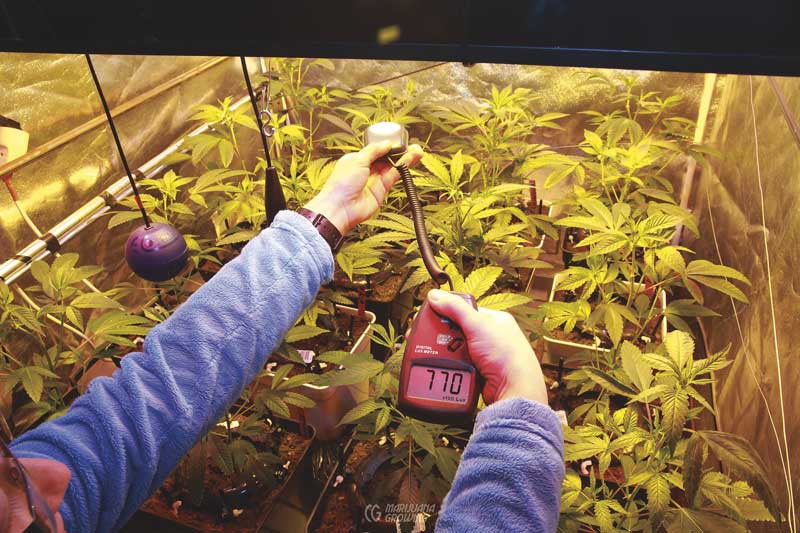
After changing a metal halide bulb for an HPS bulb at the initiation of flowering, light intensity was tested to ensure high light levels.
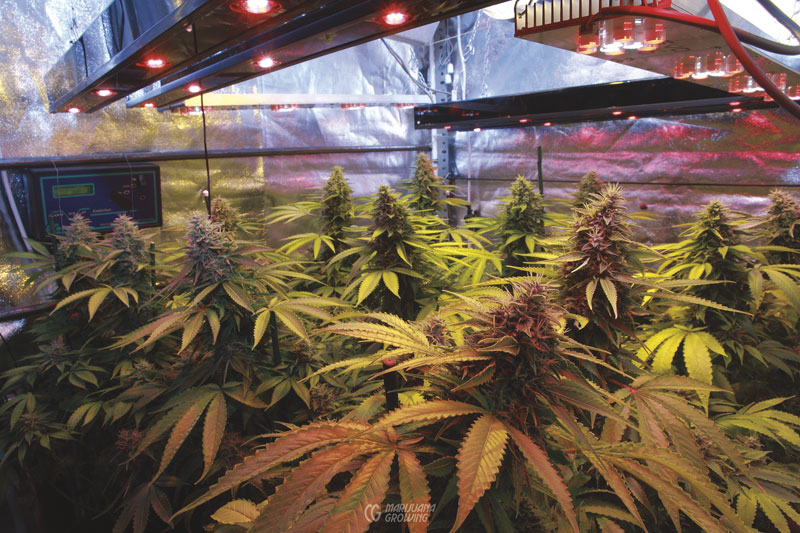
This beautiful view of the garden shows 600-watt HPS and 420-watt LED fixtures illuminating 16 flowering plants growing in 3-gallon (11.4 L) containers. The electronic ballasts made it possible to regulate the intensity of HID light emitted.
Toni used only high-quality Cree or Osram LEDs. He cited the notable difference in manufacturing process that makes these LEDs brighter and more long-lasting. LED technology is changing rapidly.
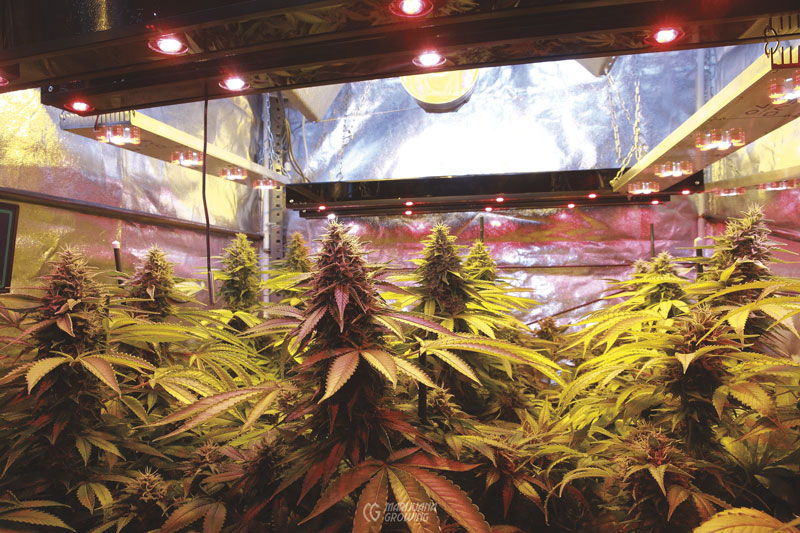
With a 600-watt HPS (Cool Tube) + 420-watts LED, light intensity/wattage could be regulated in both fixtures. Light intensity and spectrum were dialed in so that plants received intense light of the proper spectrum. Quickly evacuating the hot air allowed for placing the HID closer to the garden’s canopy.
Electronic ballasts allowed Toni to increase light output when necessary. Plants needed lower light levels during vegetative growth, so light output was cut to 400 watts to save electricity without affecting growth rate.
Air
| AIR QUALITY | ||
| Quality | Day | Night |
| temperature | 75ºF (23.9ºC) | 68ºF (20ºC) |
| humidity | 40% | 50% |
| ventilation | 238 cfm (405 m3/h) inline fan | 195 cfm (330 m3/h) inline fan |
| circulation | 14-inch (35 cm) oscillating fan | 14-inch (35.6 cm) oscillating fan |
| CO2 | 800–1.000 ppm | not used |
| sulfur burner | not used | used after lights-out every 7–10 days |
| fragrance | activated carbon filter, ozone generator | activated carbon filter, ozone generator |
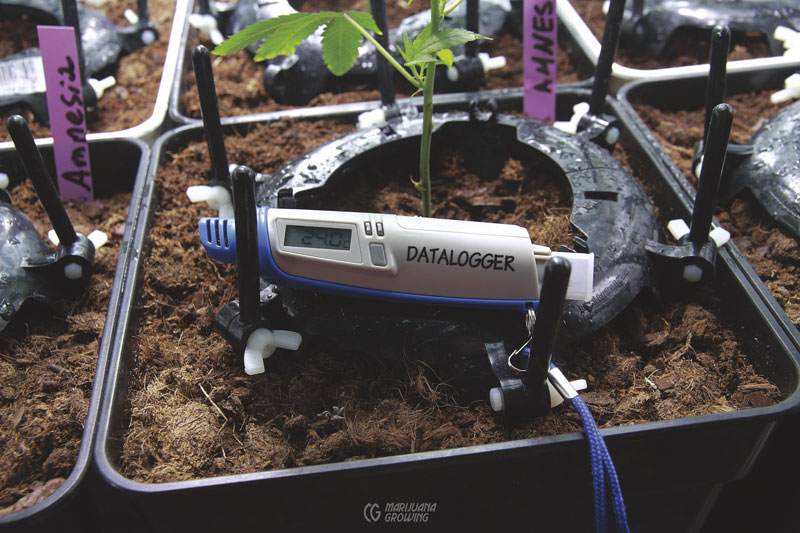
The device shown here measured temperature and humidity and logged it so Toni could download data via a USB connection. Internal memory holds 32,000 records.
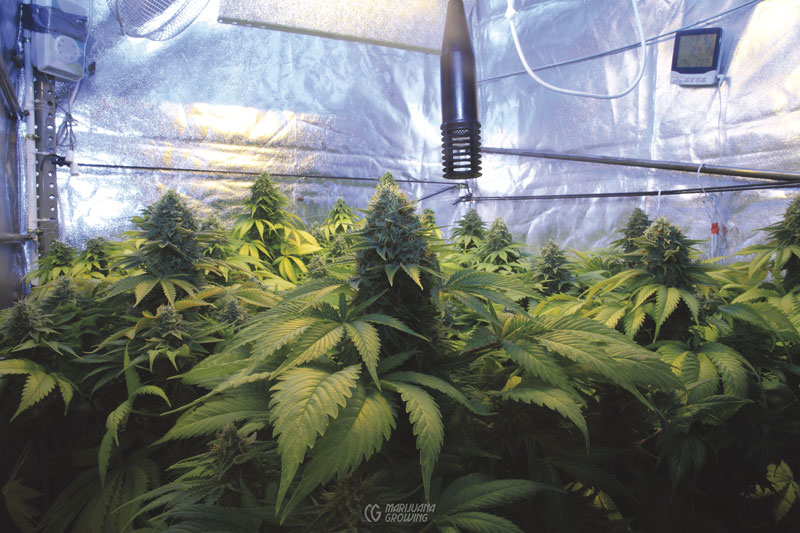
Horizontal bars in the grow tent added structure so the walls would not bow in from negative pressure created by the extractor fan. This roomful of ‘Kalashnikova’ flowered for 48 days under a 600-watt HPS lamp. There were four thermometers in the room: one above, one at the plant canopy, one in the plants, and the other on the floor to measure temperature at different levels.

Light from a 600-watt HPS and 300- watt LEDs was optimized with a CO2 generator and analyzer from Ecotechnics. Toni found that adding CO2 during vegetative growth increased growth by 10 to 20 percent. At the same time, he advised that CO2 is the last thing to add to optimize garden production.
Sulfur Burner
Toni turned on the sulfur burner as a preventive measure against diseases and pests—a weekly application during vegetative growth only. Vaporized sulfur lands on foliage, quelling diseases and pests—Botrytis, spider mites, and thrips. Remember that sulfur burners have a small coverage area; sulfur tends to fall close to where it was vaporized..
Sulfur sublimes (changes from a solid to a gas) between 291ºF and 311ºF (143.9ºC–155ºC). At 320ºF (160ºC), toxic sulfuric acid forms. This is why it is super important to use and maintain quality equipment.
Water and Fertilizer
| FERTILIZER AND ADDITIVE SCHEDULE | |||||
| Growth Stage | Fertilizer/ Additive | pH | Dose in ml/L | To Start | Weekly |
| seedling | Root Juice | 0 | max. EC 0,4 | 0 | |
| vegetative | BioGrow + Root Juice | 5,6 | 0 | max. EC 0,8 | max. EC 0,8 |
| flowering | BioBloom + BioGrow | 6,2 | follow instructions on label | EC 0,8-1,0 | increase from 200 mS each week to max of 1800 mS |
This was Toni’s base schedule for fertilizer and additives. He was also experimenting with other Biobizz fertilizers at the time of my visits to his garden.
Water came out of Toni’s tap with 1,100 ppm of dissolved solids (salts). A reverse osmosis filter was used to purify raw water before adding fertilizer.
The substrate was Coco-Mix Biobizz. Toni added a finger-deep layer of expanded clay pellets at the bottom of each container before filling it, and he left a little extra space on top to hold water.
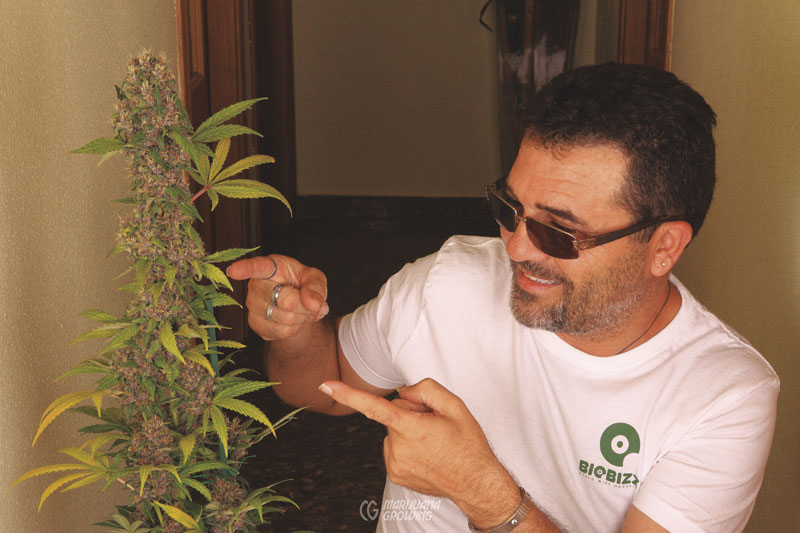
Toni with ‘Mr. Bubba’!
Flowering
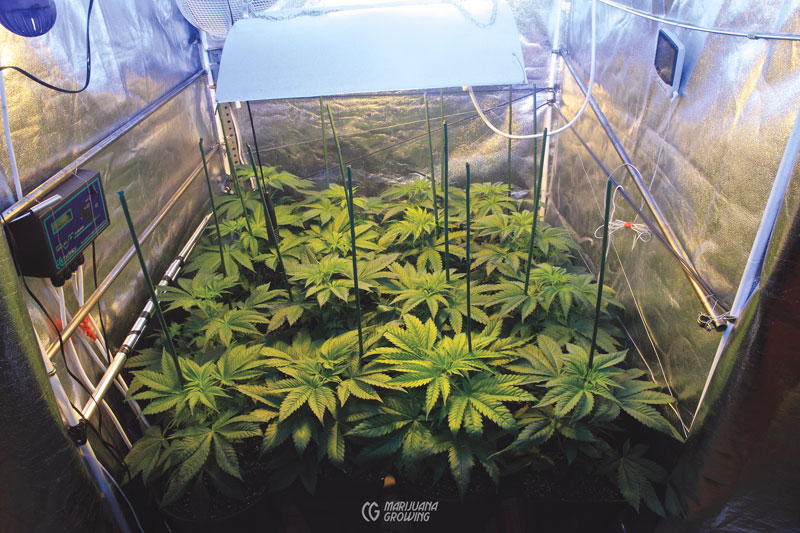
Eight feminized ‘Black Jack’ and 8 feminized ‘Jack 47’ in 3-gallon (11.4 L) containers are packed into the 48 × 48- inch square (1.2 × 1.2 m) grow tent. Toni found this the most efficient configuration for growing medicinal cannabis.
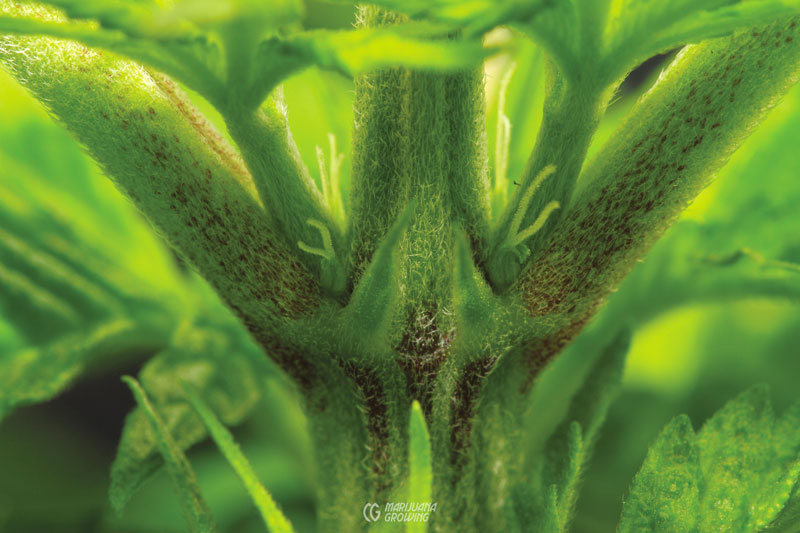
Note the white female stigmas at the seventh internode from the top of this feminized ‘Kalashnikova’ at 37 days of growth.
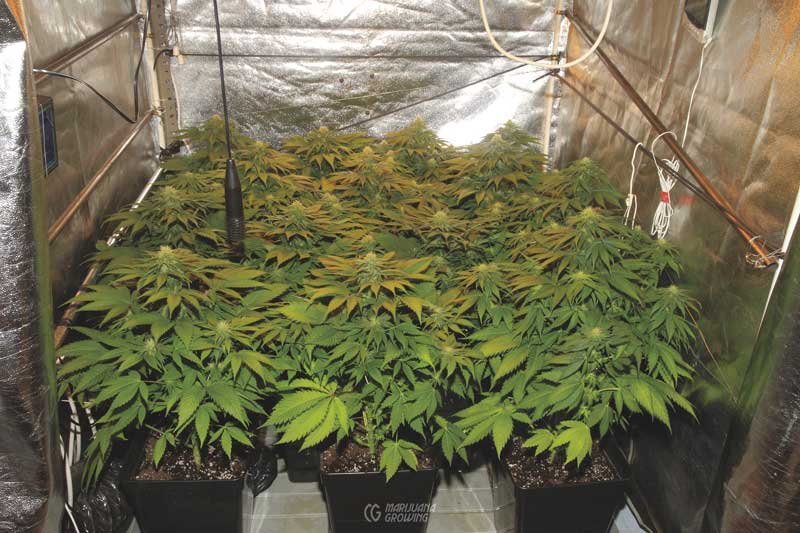
Here is the garden under a 600-watt HPS at 25 days of flowering.
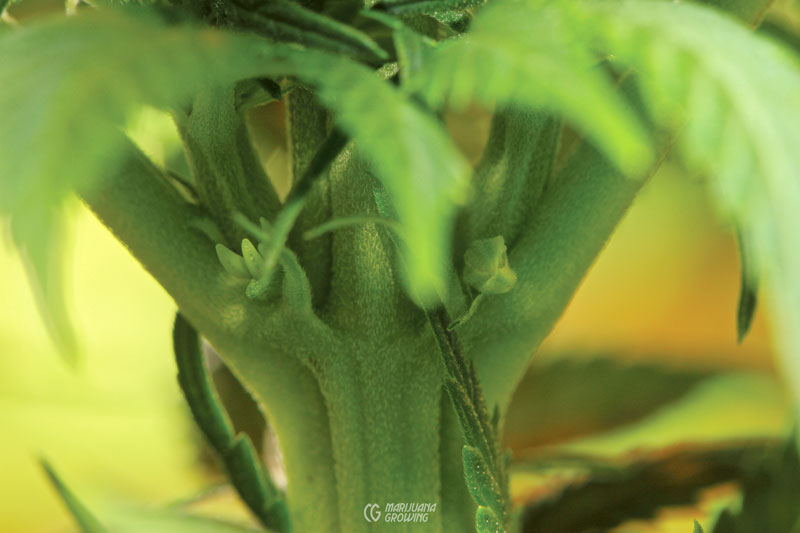
Note the male (intersex) flower on a feminized female plant after 14 days of flowering.
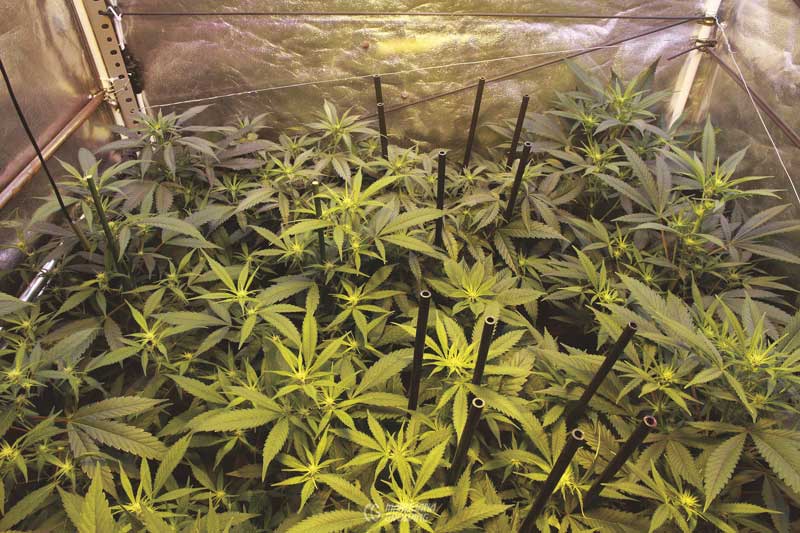
Some of the plants in this experiment were trellised using a “plant cage” with six stakes. Plants grew so densely that they covered the entire cultivation area. You could not see the floor!
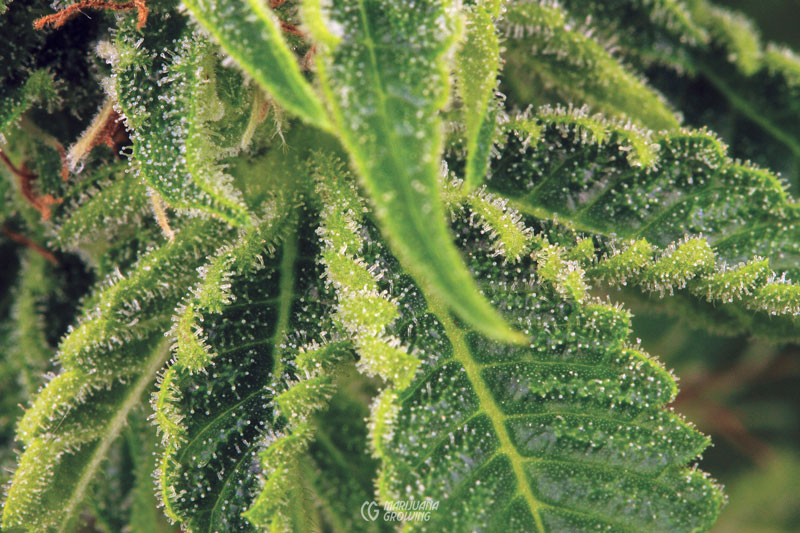
By day 43 of flowering, leaves next to this feminized ‘Kalashnikova’ bud were packed with resin along the edges, and formed a small spiral.
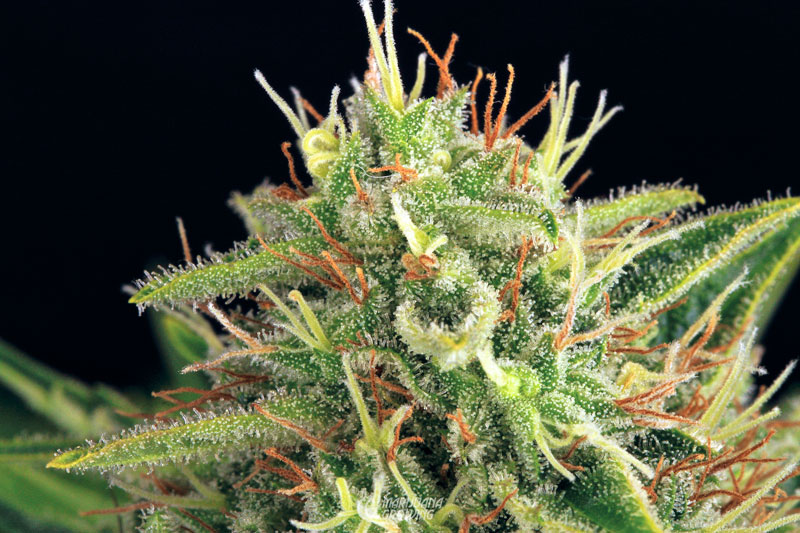
Bud of feminized ‘Kalashnikova’ at 49 days of flowering.
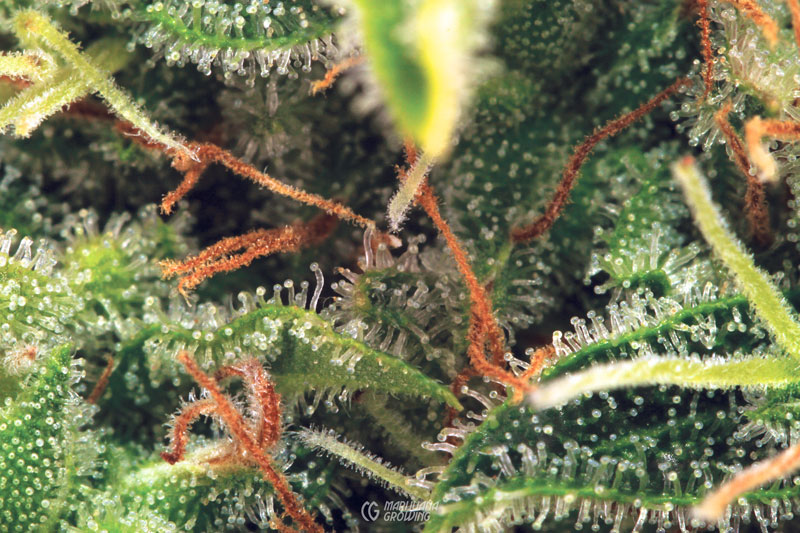
Look closely at the glandular trichomes on this feminized ‘Kalashnikova’ at 44 days of flowering, and you can see the first amber trichomes and a few broken resin heads.
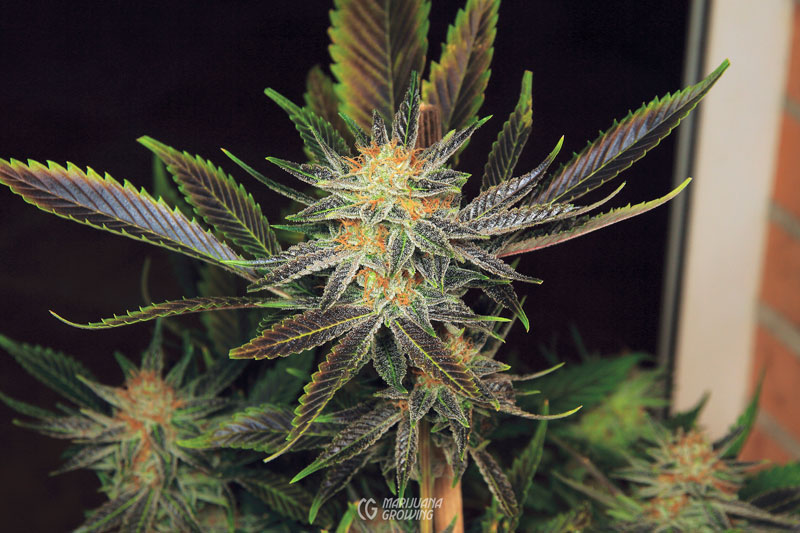
On harvest day, after 53 days of flowering, this terminal bud of a ‘Lavender’ female (Soma Seeds) was packed with resin.
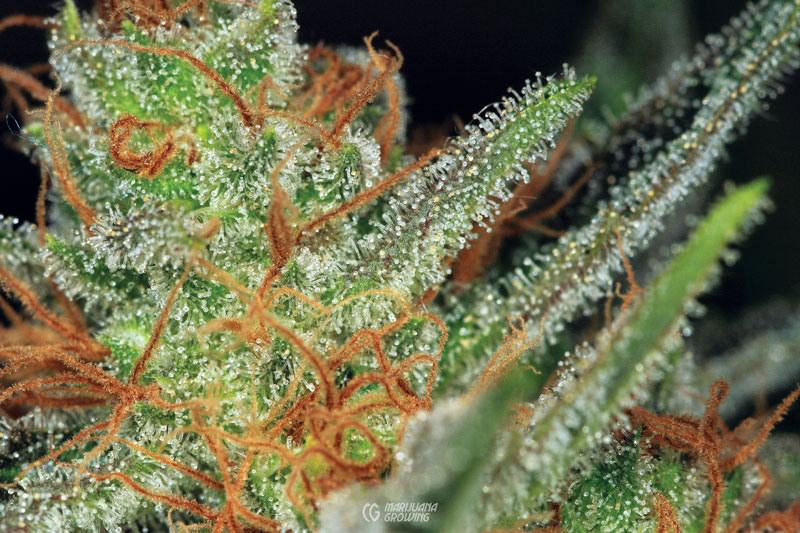
In this macro close-up of a ‘Lavender’ bud at 53 days of flowering, you can see that about 10 percent of the resin glands have turned amber.

This photo of a feminized ‘Kalashnikova’ (phenotype) at 57 days of flowering was snapped on harvest day.
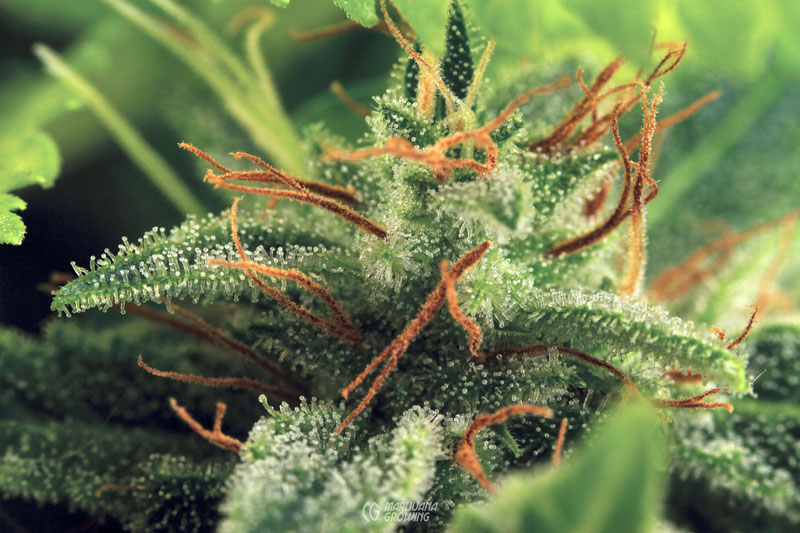
This is a different bud (phenotype) of feminized ‘Kalashnikova’ at 57 days of flowering at harvest. Note the subtle differences between this phenotype and the phenotype shown at left.
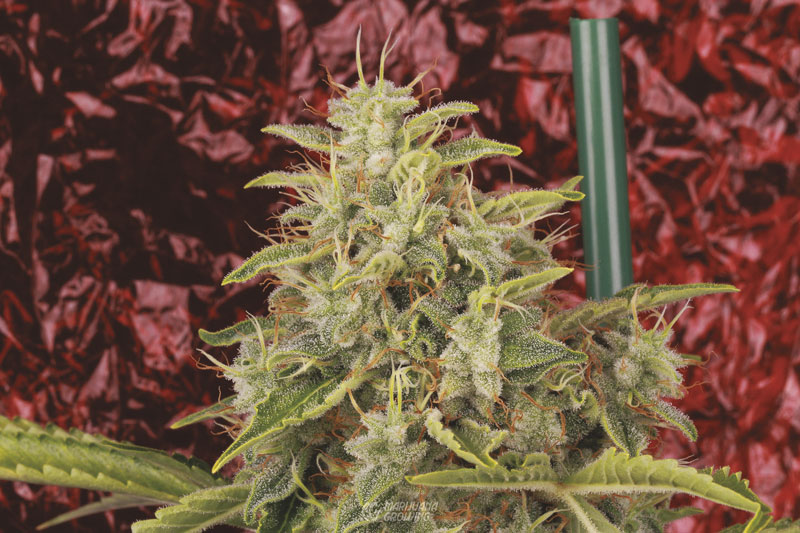
Here is a terminal bud of a ‘Somango’ female (Soma Seeds) at 68 days of flowering, 2 days before harvest.
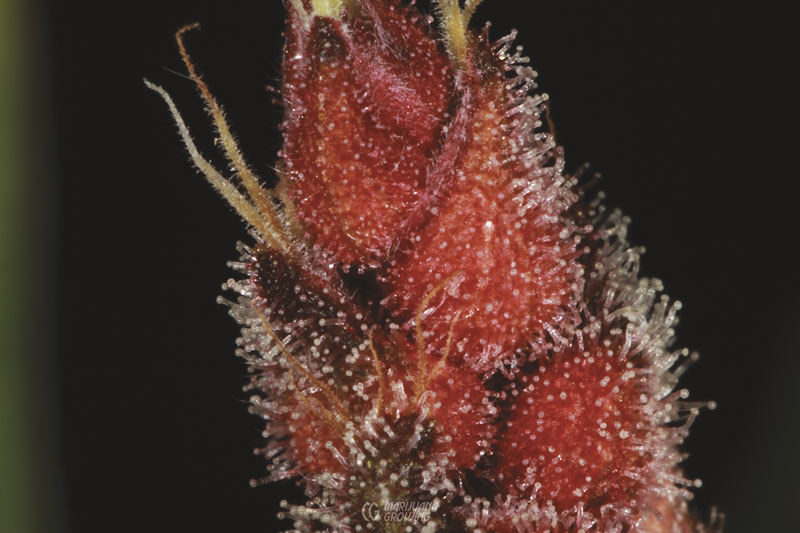
A close-up shows the tip of a bud of ‘Pakistan Chitral Kush’ (CannaBioGen). The blood-red color is seldom seen.
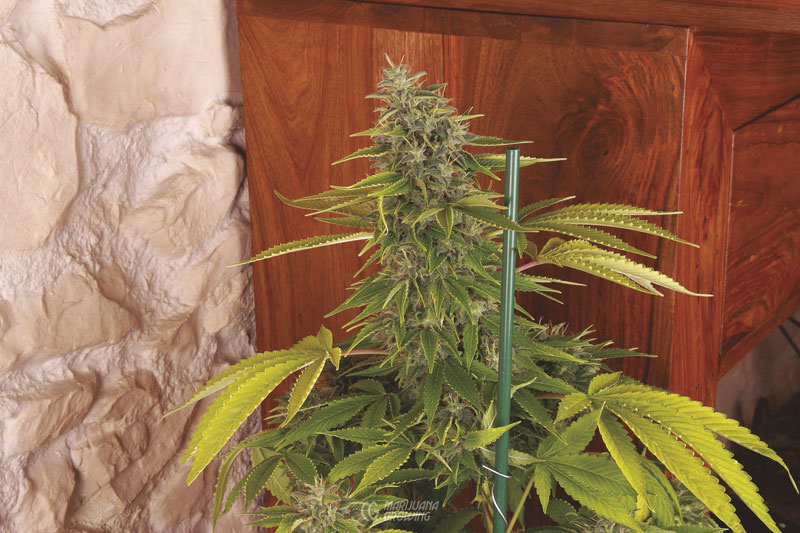
This ‘Somango’ in a 3-gallon (11.4 L) container was ready to harvest after 70 days of flowering. Large, older leaves exhibited chlorosis caused by washing nitrogen from the soil.
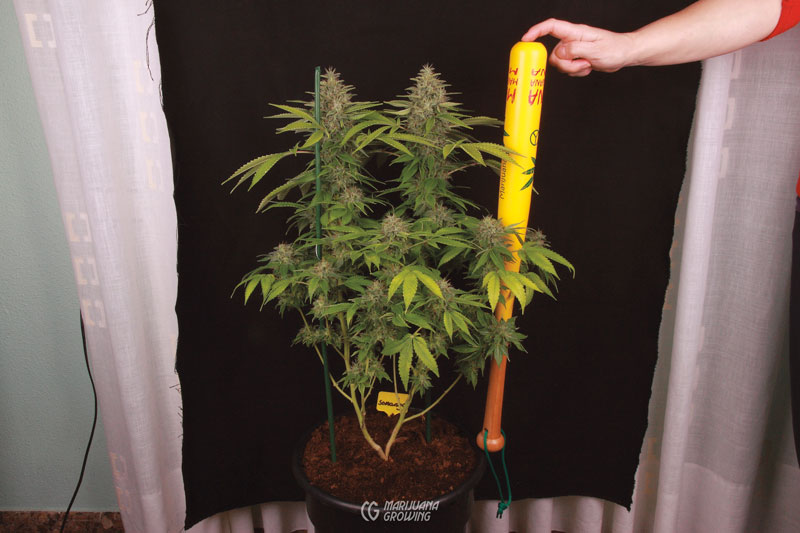
This ‘Somango’ was pruned to leave just 2 main branches. The result was a single plant that grew as if it were 2 individual plants.
Toni harvested 4 plants at a time in a perpetual-harvest rotation. Depending upon the variety and growth conditions, each plant weighed in at between 2 and 2.3 ounces (60–65 gm) of dried medicinal flower buds.

